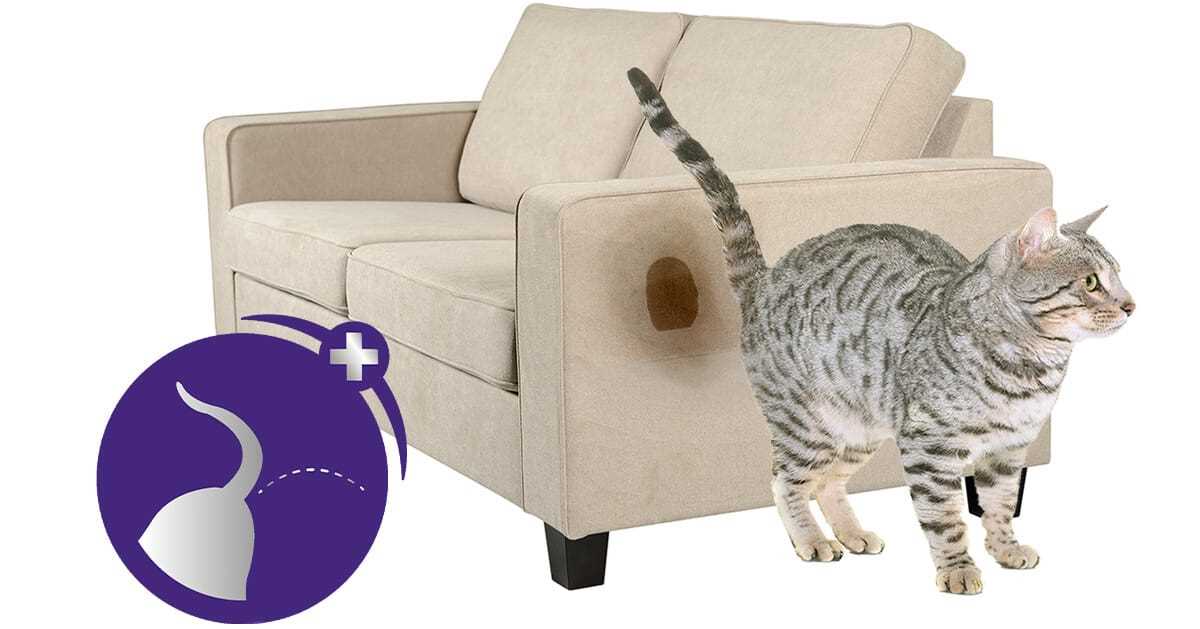I’ve learned that keeping my favorite napping spots safe from unwanted surprises starts with a clean litter box. My human must ensure it’s scooped daily and refreshed regularly. A tidy space encourages me to use it instead of looking for alternative spots.
Using attractants like catnip or special litter can make my litter area more appealing. There are also training aids available that can help guide me back to the right place when I stray.
Creating a designated area with plenty of options is another trick. I need choices to feel comfortable. If I have multiple litter boxes in different locations, I’m less likely to seek out a cozy corner of the couch.
Lastly, my human should consider using deterrents for areas I might target. This could include sprays that are safe for me but unappealing to my senses. Keeping me engaged with toys and interactive playtime also reduces my urge to mark my territory on their favorite chair.
Identify and Address Underlying Medical Issues

First, schedule a vet visit. Health problems can cause unwanted behaviors. Look for signs like frequent trips to the litter box, straining, or blood in urine.
Common medical conditions include:
- Urinary tract infections (UTIs)
- Bladder stones
- Kidney disease
- Diabetes
- Hyperthyroidism
Diagnostic tests may include:
- Urinalysis
- Blood tests
- X-rays or ultrasound
Follow your vet’s recommendations for treatment. Medications or dietary changes might be necessary. Monitor any changes in behavior or health closely.
Remember, a healthy body contributes to a happy mind. Addressing these issues can lead to improved habits and a more harmonious living environment.
Implement Behavioral Modifications and Training Techniques

Establish a consistent routine for litter box access. I appreciate having a designated time for my bathroom breaks, which helps reinforce positive habits. Make sure the box is always clean and easily accessible, as cleanliness is key to encouraging me to use it.
Use positive reinforcement to reward desirable behavior. When I choose the litter box over a forbidden spot, offer treats or affection to create a strong association with the correct choice. This method significantly boosts my motivation to stick to the right place.
Introduce deterrents in areas where I tend to misbehave. For instance, placing double-sided tape or aluminum foil on surfaces I avoid can make those areas less appealing. Additionally, utilizing citrus-scented sprays can discourage me from returning to those spots.
Engage in play sessions to reduce my stress levels. Regular exercise helps me expend energy and can lead to fewer behavioral issues. Create an interactive environment with toys that stimulate my natural hunting instincts, keeping me entertained and satisfied.
Consider litter box preferences. Experiment with different types of litter, as I might favor a particular texture or scent. Finding what I like can significantly influence my willingness to use the box consistently.
Limit access to tempting areas when unsupervised. If certain rooms often attract my attention for inappropriate activities, consider closing doors or using baby gates to prevent access. This approach can help break the habit over time.
Provide multiple litter boxes in different locations, especially in multi-level homes. This setup ensures I have options available nearby, reducing the likelihood of accidents due to distance or inconvenient locations.
Monitor my health for any signs of anxiety or stress. If I exhibit changes in behavior, consider consulting with a veterinarian or a behaviorist to explore solutions tailored to my specific needs and temperament.
Utilize Deterrents and Protective Measures
To safeguard surfaces, consider using pet-safe sprays designed to deter unwanted behavior. These products emit scents unpleasant to a feline’s sensitive nose, effectively discouraging them from approaching the area. Ensure the spray is safe for both pets and the materials of your items.
Physical Barriers
Employing physical barriers can be a straightforward solution. Furniture covers or slipcovers protect your upholstery from accidents. Choose materials that are easy to clean and resistant to stains. Alternatively, you can place aluminum foil or double-sided tape on areas where mischief tends to occur; the texture is often off-putting for curious paws.
Creating Alternative Spaces

Designate specific areas for your furry friend to feel comfortable. A cozy bed or a designated litter box can provide an appealing alternative to your belongings. Ensure these spaces are easily accessible and equipped with the right amenities. Redirecting attention to these spaces can reduce the temptation to target your possessions.
For dietary inquiries, check out this link: can cats eat lentils.
I’ve learned that keeping my favorite napping spots safe from unwanted surprises starts with a clean litter box. My human must ensure it’s scooped daily and refreshed regularly. A tidy space encourages me to use it instead of looking for alternative spots.
Using attractants like catnip or special litter can make my litter area more appealing. There are also training aids available that can help guide me back to the right place when I stray.
Creating a designated area with plenty of options is another trick. I need choices to feel comfortable. If I have multiple litter boxes in different locations, I’m less likely to seek out a cozy corner of the couch.
Lastly, my human should consider using deterrents for areas I might target. This could include sprays that are safe for me but unappealing to my senses. Keeping me engaged with toys and interactive playtime also reduces my urge to mark my territory on their favorite chair.
Identify and Address Underlying Medical Issues

First, schedule a vet visit. Health problems can cause unwanted behaviors. Look for signs like frequent trips to the litter box, straining, or blood in urine.
Common medical conditions include:
- Urinary tract infections (UTIs)
- Bladder stones
- Kidney disease
- Diabetes
- Hyperthyroidism
Diagnostic tests may include:
- Urinalysis
- Blood tests
- X-rays or ultrasound
Follow your vet’s recommendations for treatment. Medications or dietary changes might be necessary. Monitor any changes in behavior or health closely.
Remember, a healthy body contributes to a happy mind. Addressing these issues can lead to improved habits and a more harmonious living environment.
Implement Behavioral Modifications and Training Techniques

Establish a consistent routine for litter box access. I appreciate having a designated time for my bathroom breaks, which helps reinforce positive habits. Make sure the box is always clean and easily accessible, as cleanliness is key to encouraging me to use it.
Use positive reinforcement to reward desirable behavior. When I choose the litter box over a forbidden spot, offer treats or affection to create a strong association with the correct choice. This method significantly boosts my motivation to stick to the right place.
Introduce deterrents in areas where I tend to misbehave. For instance, placing double-sided tape or aluminum foil on surfaces I avoid can make those areas less appealing. Additionally, utilizing citrus-scented sprays can discourage me from returning to those spots.
Engage in play sessions to reduce my stress levels. Regular exercise helps me expend energy and can lead to fewer behavioral issues. Create an interactive environment with toys that stimulate my natural hunting instincts, keeping me entertained and satisfied.
Consider litter box preferences. Experiment with different types of litter, as I might favor a particular texture or scent. Finding what I like can significantly influence my willingness to use the box consistently.
Limit access to tempting areas when unsupervised. If certain rooms often attract my attention for inappropriate activities, consider closing doors or using baby gates to prevent access. This approach can help break the habit over time.
Provide multiple litter boxes in different locations, especially in multi-level homes. This setup ensures I have options available nearby, reducing the likelihood of accidents due to distance or inconvenient locations.
Monitor my health for any signs of anxiety or stress. If I exhibit changes in behavior, consider consulting with a veterinarian or a behaviorist to explore solutions tailored to my specific needs and temperament.
Utilize Deterrents and Protective Measures
To safeguard surfaces, consider using pet-safe sprays designed to deter unwanted behavior. These products emit scents unpleasant to a feline’s sensitive nose, effectively discouraging them from approaching the area. Ensure the spray is safe for both pets and the materials of your items.
Physical Barriers
Employing physical barriers can be a straightforward solution. Furniture covers or slipcovers protect your upholstery from accidents. Choose materials that are easy to clean and resistant to stains. Alternatively, you can place aluminum foil or double-sided tape on areas where mischief tends to occur; the texture is often off-putting for curious paws.
Creating Alternative Spaces

Designate specific areas for your furry friend to feel comfortable. A cozy bed or a designated litter box can provide an appealing alternative to your belongings. Ensure these spaces are easily accessible and equipped with the right amenities. Redirecting attention to these spaces can reduce the temptation to target your possessions.
For dietary inquiries, check out this link: can cats eat lentils.
I’ve learned that keeping my favorite napping spots safe from unwanted surprises starts with a clean litter box. My human must ensure it’s scooped daily and refreshed regularly. A tidy space encourages me to use it instead of looking for alternative spots.
Using attractants like catnip or special litter can make my litter area more appealing. There are also training aids available that can help guide me back to the right place when I stray.
Creating a designated area with plenty of options is another trick. I need choices to feel comfortable. If I have multiple litter boxes in different locations, I’m less likely to seek out a cozy corner of the couch.
Lastly, my human should consider using deterrents for areas I might target. This could include sprays that are safe for me but unappealing to my senses. Keeping me engaged with toys and interactive playtime also reduces my urge to mark my territory on their favorite chair.
Identify and Address Underlying Medical Issues

First, schedule a vet visit. Health problems can cause unwanted behaviors. Look for signs like frequent trips to the litter box, straining, or blood in urine.
Common medical conditions include:
- Urinary tract infections (UTIs)
- Bladder stones
- Kidney disease
- Diabetes
- Hyperthyroidism
Diagnostic tests may include:
- Urinalysis
- Blood tests
- X-rays or ultrasound
Follow your vet’s recommendations for treatment. Medications or dietary changes might be necessary. Monitor any changes in behavior or health closely.
Remember, a healthy body contributes to a happy mind. Addressing these issues can lead to improved habits and a more harmonious living environment.
Implement Behavioral Modifications and Training Techniques

Establish a consistent routine for litter box access. I appreciate having a designated time for my bathroom breaks, which helps reinforce positive habits. Make sure the box is always clean and easily accessible, as cleanliness is key to encouraging me to use it.
Use positive reinforcement to reward desirable behavior. When I choose the litter box over a forbidden spot, offer treats or affection to create a strong association with the correct choice. This method significantly boosts my motivation to stick to the right place.
Introduce deterrents in areas where I tend to misbehave. For instance, placing double-sided tape or aluminum foil on surfaces I avoid can make those areas less appealing. Additionally, utilizing citrus-scented sprays can discourage me from returning to those spots.
Engage in play sessions to reduce my stress levels. Regular exercise helps me expend energy and can lead to fewer behavioral issues. Create an interactive environment with toys that stimulate my natural hunting instincts, keeping me entertained and satisfied.
Consider litter box preferences. Experiment with different types of litter, as I might favor a particular texture or scent. Finding what I like can significantly influence my willingness to use the box consistently.
Limit access to tempting areas when unsupervised. If certain rooms often attract my attention for inappropriate activities, consider closing doors or using baby gates to prevent access. This approach can help break the habit over time.
Provide multiple litter boxes in different locations, especially in multi-level homes. This setup ensures I have options available nearby, reducing the likelihood of accidents due to distance or inconvenient locations.
Monitor my health for any signs of anxiety or stress. If I exhibit changes in behavior, consider consulting with a veterinarian or a behaviorist to explore solutions tailored to my specific needs and temperament.
Utilize Deterrents and Protective Measures
To safeguard surfaces, consider using pet-safe sprays designed to deter unwanted behavior. These products emit scents unpleasant to a feline’s sensitive nose, effectively discouraging them from approaching the area. Ensure the spray is safe for both pets and the materials of your items.
Physical Barriers
Employing physical barriers can be a straightforward solution. Furniture covers or slipcovers protect your upholstery from accidents. Choose materials that are easy to clean and resistant to stains. Alternatively, you can place aluminum foil or double-sided tape on areas where mischief tends to occur; the texture is often off-putting for curious paws.
Creating Alternative Spaces

Designate specific areas for your furry friend to feel comfortable. A cozy bed or a designated litter box can provide an appealing alternative to your belongings. Ensure these spaces are easily accessible and equipped with the right amenities. Redirecting attention to these spaces can reduce the temptation to target your possessions.
For dietary inquiries, check out this link: can cats eat lentils.






